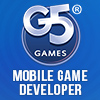Abylight is a Barcelona-based independent video game development studio founded in 2004 by Nacho Garcia, Alberto Gonzalez, Daniel Lopez and Ricardo Fernandez and based in Barcelona. The studio has been developing titles since 1990, resulting in more than 60 titles for various platforms, such as the Nintendo 3DS, Nintendo Wii, and Sony Playstation Portable. Abylight has also released games for digital distribution platforms such as WiiWare, DSiWare, PSN, and iOS.
After the initial development and publishing of Fish’em All! and Stop Stress for WiiWare in 2009, Abylight sadly found itself depleted of resources. Only a very tight core team survived and no financial room was left to invest in any kind of independent development. Around the same time, the Nintendo DSi was released and the DSiWare digital store was launched. Earlier, in 2008, Abylight developed Elite Forces: Unit 77 for Nintendo DS, which meant that we had several development kits and all the legal authorizations necessary ready to develop for the platform. Although technically a DS is different from a DSi (i.e. camera-wise), we sorted it out easily, just ignoring those differences in our first productions. Moving from WiiWare to DSiWare was not an issue at all. The decision to focus on the DSi platform would eventually lead to the creation of our first iOS project: AfterZoom.

An idea is born
Looking into what kind of games had been published on the DSiWare service, our studio head Nacho Garcia realized that there are only a couple of games on the marketplace using the camera as a game play feature. How can we play with the camera? What fun can we have with this feature? Hot topics at that moment were augmented reality, hidden objects, collecting and time management. This got Nacho thinking and one day, walking through a park and looking at the fallen autumn leaves laying on the ground in heaps, he imagined what would be seen if one was to use a microscope: there would be lots of tiny creatures.
And so the initial concept for AfterZoom was born: turn the camera into a microscope to capture microbes, collect them and exchange them with other friends. But how could we easily implement such advanced features into a limited console like the Nintendo DSi? The first challenge would be funding. A first draft was prepared to attract local investors, but with no success. So we decided to let the idea rest for a while (as so many ideas do), until a better moment would arise. The idea fell in the good-but-not-possible-yet drawer and Abylight concentrated on developing and releasing the Music On series for Nintendo DSiWare.
Looking for funding
The work we got from various services and developing the Music On-series did wonders for Abylight. Money was finally coming in again. Moreover, the Spanish Ministry of Culture set up a grant where a videogame can be submitted for funding. Long story short, on July 2010 we received a small grant from the Ministry to develop a game. The grant, however, required the game to have an educational side. So the game, at that time, was simply titled Microscope. In the summer of 2010, we produced an evolved concept of the game and pitched it to publishers in order to get the rest of the sum needed to complete the development. However, with no success.
Because of the grant requisites, we had to develop the game within 2010. Adding some income from other games we had released on the DSiWare service, we were able to finance the rest of the development of AfterZoom. The decision was made to downscale the game to concentrate on the three key gameplay features and develop it independently.

Finally, developing AfterZoom
Development started on September 2010. We cut down the planned collection of micro-organisms from 300 to 50 species, limited the A.I. (as originally the game should have been played more Pokemon-like) and disregarded the multiplayer feature, both from the technical and the gameplay point of view. Basically, we thought of the project as a prototype of what it could really be. Still, some issues did arise.
Issue #1: the gyroscope
The Nintendo DSi is a console that doesn’t have a gyroscope, which is quite essential for an Augmented Reality game. This meant that we had to develop an optical flow algorithm to establish how the console is moving based on the captured image of the camera. The original Optical Flow Algorithm was developed on a desktop with a webcam, Intel i7 processor and using floating point numbers: everything worked just fine. The DSi, however, has a slow ARM Processor and uses fixed point arithmetic. So when we ported the optical flow algorithm the entire process was very slow, not even reaching 3 frames per second. Moreover, the quality of the captured image was very low, especially in bad lighting situations (i.e. indoors). These issues brought the team to the brink of desperation and almost capitulation. After all, this main feature didn’t work as planned, meaning we might had to cancel the project.
However, we weren’t going to break because of this big issue. We faced the situation with perseverance. We proceeded to optimize the optical flow algorithm: making endless image contrast tests, reducing the analyzed area captured, interpolating frames and assisting the player (when in a situation the game gets two ambiguous readings, it will always produce the expected result). In situations with bad lighting we added keyboard control to avoid errors. This way, we managed to overcome the issues and continue development on AfterZoom.
Issue #2: colourful landscapes
Surface detection is basically done by determining the dominant colour captured by the camera. The problem that arises is that depending on the illumination while playing, the camera of the console changes the captured colour.
In order to solve this and harmonize the game experience, we did two things. First, we reduced the range of playable colours, eliminating colours that could be easily confused, like orange to red. So when the camera captured orange produce the gameplay destined for red. Second, the game would assist the player, generating the required element at each moment in order to avoid ambiguities.
Unfortunately, after overcoming these and more issues the project was delayed. Besides, we weren’t sure if we would receive a worthy return from our investment. But at least we were finally working on our game.
Publishing, on our own
Several times we felt like the pressure was too much and we thought about just finishing the project and be over with it. But we couldn’t succumb to the inevitable need to leave a project behind after so many hardships and we really took the time to polish it. As a result, the development officially ended on April 2011. At the time, we already had 10 published games on the Nintendo DSiWare service. This meant we knew what we were doing and we knew some tricks. The first thing was giving the project a commercial name. The original one, Microscope, wasn’t good enough. We wanted a new title and we had a couple of requisites: it needed to start with an “A” and it needed to be a self-explanatory. We settled on AfterZoom.
After coming up with a title, we produced a trailer for the game, to be released on the DSiWare service. Actors, voice-overs, cameras… everything! We knew we needed to communicate our game as good as possible. Because we were directly talking to the final consumer - the kids – there was no mention of the educational side effects. The trailer focused just on the fun part.
The game was released in America on July 14th 2011 for a price of around $5. In Europe, the game was released on July 21st 2011 for 5€. As it turned out, we couldn’t have been more expectant with the performance of a game that we thought would not be able to turn into a profit. Sales numbers weren’t that impressive at first. But then, what normally would be a downfall turned out into an unexpected rollercoaster that we had never seen before.
Some time after the game was published, the sales were good, kids loved the game and Nintendo’s digital distribution channel was very supportive. On October 26th 2011, we published the game in Japan as well through Kawamoto Industrial. Albeit with a change in price: our partners felt that ¥200 yen games did better, which turned out to be true because the game immediately became a number one success in Japan.
Multi-platform, what else?
After the success of the game worldwide, we decided to adapt the game to the thriving platform of Apple: iOS and its AppStore. Because of this, in order to optimize our developments and processes, we created an engine that allowed us to simultaneously work for several platforms, such as iOS and Nintendo consoles. This way, while building this engine, we were able to also port AfterZoom to iOS.
Developing for iOS, we made several bad assumptions, like the iPhone being a lot more powerful than it really was. Graphically, we picked OpenGL 2, which worked fine on the iPhone 4S. However, the game had to work on older models too, so we had to optimize the engine and remove graphical features and replace them with fakes. Besides, the iPhone 3G lacks gyroscope, so we had to implement similar tricks as we did with the DSi. These issues only seemed minor when we were faced with the next issue: the business model.
From premium to freemium
Porting AfterZoom to iOS, we expected to release a fuller version under the premium model. We worked on an improved design, 3D graphics and smoother presentation. However, while pitching the project to publishers it was made clear that, even if the game was very well received, the premium model was not interesting at all. iOS was a platform that was dominated by freemium releases. Freemium, free-to-play, that was the way to go.
But, what did we know about freemium games? Next to nothing, we played some of them on Facebook, we had some colleagues explain it to us over coffee and we had gathered some knowledge from conferences on the subject. All in all, not much.
First option: freemium
We started toying with the possibility of releasing the game exactly as it was. Instead of selling it as a premium game, we would present it as a freemium. This way the game could be released almost immediately (summer 2012), and we could start monetizing to lower any financial risks, while at the same time keep developing the game. The problem was that turning a premium game into a freemium one does not only involve adding features, elements and shopping opportunities. It is about a certain coherence and goal, which can be adapted, expanded and evolved later on.

Second option: free-to-play

The second option, the one we believe is the better one, was releasing the game free-to-play from the start. To do so, we delved deep into all the information available and took a good look at our game. From the start, AfterZoom used elements that were popular and easily found in F2Ps, such as collecting, time management, missions, et cetera. So we focused on each element and researched the most successful games in the Apple AppStore: how did they get popular? How did the games work? How did they monetize?
After seeing a couple of games, we realized a couple of important things: top-selling games are simple and easy, usually a copy of a copy of a copy. We either had an opportunity or damnation with our original and unique game.

Changing the design
Console games are closed, there’s no adding features to a physical disk. On iOS you keep developing and improving after the release. The first major decision was to turn AfterZoom into a more tycoon-like game. To do so in economic terms, we also had to change how the microorganisms would be developed; instead of creating original forms we used texture settings. We prepare a schedule of how the game could grow and evolve: which features would be implemented, when and how to entice the players to keep playing after the first try, week or month. This way we tried to make Afterzoom iOS-proof.
Currently, AfterZoom for iOS is still in development. However, you can still check out AfterZoom for DSiWare. Abylight is currently working on a work for hire project and the improvement of its own multi-platform engine Afrodita V.
Comments










